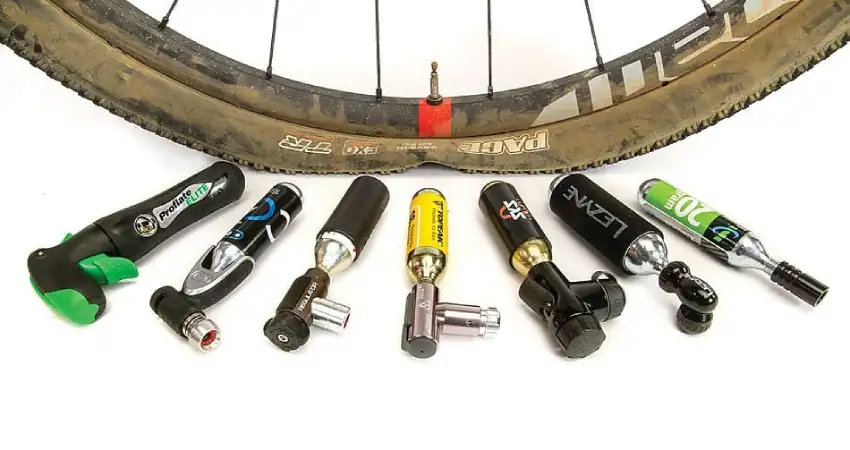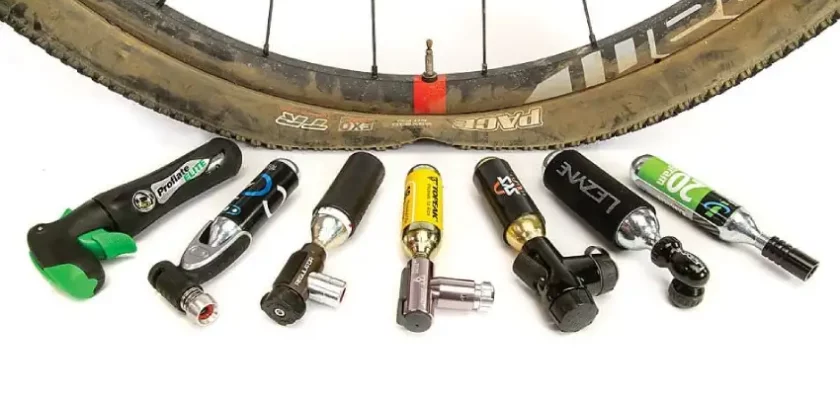Have you ever found yourself with a flat tire in the middle of a trail during a mountain biking adventure? It’s not an uncommon occurrence, but knowing how to quickly and efficiently inflate your tires can save you a lot of time and frustration.
That’s where CO2 cartridges come in handy, providing a fast and portable solution for reinflating your tires on the go.
But the question remains – how many CO2 cartridges do you actually need to fill a mountain bike tire? It’s a common query among riders, and today, we’ll dive into the answer.
Whether you’re a seasoned cyclist or just starting out, understanding the right amount of CO2 cartridges to use can make a significant difference in your biking experience.
So, let’s explore this topic and discover the optimal number of CO2 cartridges to fill a mountain bike tire, ensuring you’re always ready to hit the trails with confidence.
How Many CO2 Cartridges to Fill a Mountain Bike Tire

The Importance of Tire Inflation
Proper tire inflation is crucial for a smooth and safe mountain biking experience. It affects your bike’s performance in terms of traction, control, and comfort. The correct tire pressure also minimizes the risk of punctures and reduces rolling resistance, therefore increasing efficiency.
While manual pumps are widely used, CO2 cartridges provide a quick and convenient alternative for inflating mountain bike tires on the go. But how many CO2 cartridges do you need to fill a mountain bike tire efficiently and effectively? Let’s delve into the details.
Understanding CO2 Cartridges
Before knowing how many CO2 cartridges you need, it’s essential to understand these handy devices. CO2 cartridges are small, cylindrical containers filled with compressed carbon dioxide gas.
They are lightweight, portable, and commonly used by cyclists to inflate their tires during bike rides or races. With a threaded valve, CO2 cartridges can easily be connected to your bike’s tire valve with a minimal amount of effort.
Filling a Tire with CO2 Cartridges: Factors to Consider
When determining the number of CO2 cartridges required to fill a mountain bike tire, several factors come into play:
- Tire Volume: Different tire sizes have varying volumes, affecting the amount of air needed. Wider tires generally require more air to achieve optimal pressure compared to narrower tires.
- Desired Pressure: Your preferred tire pressure also influences the number of cartridges needed. Higher pressures require more gas to fill the tire adequately.
- CO2 Cartridge Size: CO2 cartridges come in different sizes, typically ranging from 12 to 25 grams. The size of the cartridge chosen affects how much air it can deliver to the tire.
Calculating CO2 Cartridge Requirements
To calculate the number of CO2 cartridges needed, you can follow a simple formula:
Number of Cartridges = (Desired Pressure – Current Pressure) / (CO2 Cartridge Size – Losses)
Let’s break down each component of this formula:
- Desired Pressure: Determine your preferred tire pressure based on trail conditions, rider weight, and personal preferences. Mountain bike tire pressures often range from 25 to 35 PSI (pounds per square inch).
- Current Pressure: Measure your tire’s current pressure using a pressure gauge. This step is crucial in ensuring accurate calculations.
- CO2 Cartridge Size: Choose the appropriate CO2 cartridge size for your specific needs. Remember to consider your tire volume and desired pressure when making this decision.
- Losses: Losses occur during the inflation process due to gas escaping while attaching and detaching the cartridge. It is recommended to account for approximately 10% loss.
Once you have determined these variables, plug the values into the formula and calculate the number of CO2 cartridges required to achieve your desired pressure.
Considerations for Different Tire Sizes
The size of your mountain bike tire plays a significant role in determining the number of CO2 cartridges needed for proper inflation. Here are some considerations based on different tire sizes:
1. 27.5″ and 29″ Tires
These larger tire sizes are commonly found on modern mountain bikes. The increased volume of these tires means they require more air to reach the desired pressure.
In general, you may need more CO2 cartridges to fill a 27.5″ or 29″ mountain bike tire than a narrower one. It is recommended to carry at least two cartridges for these larger tire sizes to ensure sufficient inflation.
2. 26″ Tires
26″ tires have been a standard for mountain biking for many years. Due to their smaller volume compared to 27.5″ and 29″ tires, they require a smaller amount of air to achieve optimal pressure.
Typically, one CO2 cartridge should be sufficient to fill a 26″ mountain bike tire effectively.
3. Tubeless Tires
Tubeless mountain bike tires have gained popularity for their ability to resist punctures, provide a smoother ride, and reduce rolling resistance. When inflating tubeless tires with CO2 cartridges, some considerations apply:
- These tires often require a higher pressure than traditional tubes, so you may need additional cartridges to reach the desired pressure.
- Tubeless tires are susceptible to losing air when initially seated on the rim, so be prepared to add extra air to ensure a proper seal.
- Keep in mind that CO2 cartridges are not recommended for long-term inflation of tubeless tires. They are best used as a quick fix to get you out of a challenging situation.
Tips and Best Practices
To ensure a successful inflation using CO2 cartridges, consider the following tips and best practices:
- Always carry spare CO2 cartridges during your rides. It’s better to have more than you need to cover unexpected situations.
- Use a pressure gauge to accurately measure your tire pressure.
- Practice using CO2 cartridges before heading out on a ride to familiarize yourself with the process.
- Avoid overinflating your tire with CO2 cartridges, as it can lead to a harsh and uncomfortable ride quality.
- Regularly check your tires for any signs of damage or wear. Replace damaged tires promptly to prevent potential blowouts.
Frequently Asked Questions
1. How many CO2 cartridges do I need to fill my mountain bike tire?
You typically need one CO2 cartridge to inflate a mountain bike tire. However, a larger tire may require two cartridges.
2. Is it possible to overinflate my tire using CO2 cartridges?
Yes, it is possible to overinflate your tire with CO2 cartridges. Be cautious and monitor the tire pressure closely to prevent damage or bursts.
3. Can I reuse a CO2 cartridge on multiple rides?
No, CO2 cartridges are single-use and cannot be reused. Make sure to carry an extra cartridge for each ride or consider investing in a pump for long-term cost savings.
4. What size CO2 cartridge do I need for my mountain bike tire?
For most mountain bike tires, a 16-gram CO2 cartridge is sufficient. However, it’s a good idea to check your tire specifications or consult a professional if you are unsure.
5. Can CO2 cartridges be used for tubeless tires?
Inflating tubeless tires with CO2 cartridges is not recommended. The rapid airflow from CO2 can cause the tubeless sealant to fail, resulting in loss of air pressure. Use a regular pump instead.
Final Thoughts
In conclusion, determining the number of CO2 cartridges required to fill a mountain bike tire can vary based on several factors, such as tire size, desired pressure, and cartridge capacity. It is crucial to consider these factors to ensure a successful and efficient inflation process.
However, understanding the basic guidelines and using the appropriate tools, such as a reliable tire gauge, can help cyclists estimate the number of cartridges needed accurately.
By being mindful of these considerations and planning accordingly, cyclists can enjoy uninterrupted rides and address any unexpected punctures or deflations promptly.
So, next time you venture out on your mountain bike, remember to keep track of how many CO2 cartridges to fill a mountain bike tire to ensure a safe and enjoyable experience.

